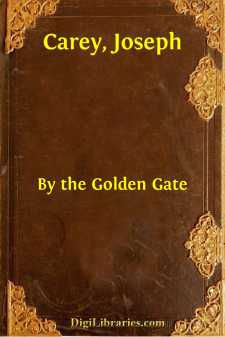Categories
- Antiques & Collectibles 13
- Architecture 36
- Art 48
- Bibles 22
- Biography & Autobiography 813
- Body, Mind & Spirit 142
- Business & Economics 28
- Children's Books 16
- Children's Fiction 13
- Computers 4
- Cooking 94
- Crafts & Hobbies 4
- Drama 346
- Education 46
- Family & Relationships 57
- Fiction 11829
- Games 19
- Gardening 17
- Health & Fitness 34
- History 1377
- House & Home 1
- Humor 147
- Juvenile Fiction 1873
- Juvenile Nonfiction 202
- Language Arts & Disciplines 88
- Law 16
- Literary Collections 686
- Literary Criticism 179
- Mathematics 13
- Medical 41
- Music 40
- Nature 179
- Non-Classifiable 1768
- Performing Arts 7
- Periodicals 1453
- Philosophy 64
- Photography 2
- Poetry 896
- Political Science 203
- Psychology 42
- Reference 154
- Religion 513
- Science 126
- Self-Help 84
- Social Science 81
- Sports & Recreation 34
- Study Aids 3
- Technology & Engineering 59
- Transportation 23
- Travel 463
- True Crime 29
By the Golden Gate
by: Joseph Carey
Description:
Excerpt
CHAPTER I
WESTWARD
Choice of Route—The Ticket—Journey Begun—Pan-American Exposition
and President McKinley—The Cattle-Dealer and His Story—Horses—Old
Friends—The Father of Waters—Two Noted Cities—Rocky Mountains—A
City Almost a Mile High—The Dean and His Anti-tariff Window—Love
and Revenge—Garden of the Gods—Haunted House—Grand Cañon and Royal
Gorge—Arkansas River—In Salt Lake City—A Mormon and His Wives—The
Lake—Streets—Tabernacle and Temple—In St. Mark's—Salt Lake
Theatre—Impressions—Ogden—Time Sections—Last Spike—Piute
Indians—El Dorado—On the Sierras—A Promised Land.
The meeting of the General Convention of the Church in San Francisco, in 1901, gave the writer the long-desired opportunity to visit the Pacific coast and see California, which since the early discoveries, has been associated with adventure and romance. Who is there indeed who would not travel towards the setting sun to feast his eyes on a land so famous for its mineral wealth, its fruits and flowers, and its enchanting scenery from the snowy heights of the Sierras to the waters of the ocean first seen by Balboa in 1513, and navigated successively by Magalhaes and Drake, Dampier and Anson?
The question, debated for weeks before setting out on the journey, was, which route of travel will I take? It is hard to choose where all are excellent. I asked myself again and again, which line will afford the greatest entertainment and be most advantageous in the study of the country from a historic standpoint? The Canadian Pacific route, and also the Northern Pacific, with their grand mountainous scenery and other attractions, had much to commend them; so also other lines of importance like the Santa Fé with its connecting roads; and the only regret was that one could not travel over them all. But one way had to be selected, and the choice at last fell on the Delaware and Hudson, the Erie, Rock Island, the Denver and Rio Grande, and the Southern Pacific roads. This route was deemed most feasible, and one that would give a special opportunity to pass through cities and places famous in the history of the Nation, which otherwise could not be visited without great expense and consumption of time. It enabled one also to travel through such great States as Pennsylvania, Ohio, Indiana, Illinois, Iowa, Nebraska, Colorado, Utah, and Nevada, as well as central California. As the return journey had also to be determined before leaving home, the writer, desirous of visiting the coast towns of California south of San Francisco, and as far down as San Diego, the first settlement in California by white men, arranged to take the Southern Pacific Railway and the direct lines with which it communicates. In travelling over the "Sunset Route," as the Southern Pacific is styled, he would pass across the southern section of California from Los Angeles, through Arizona, New Mexico, Texas and Louisiana, the line over which President McKinley travelled when he made his tour in the spring of 1901....


